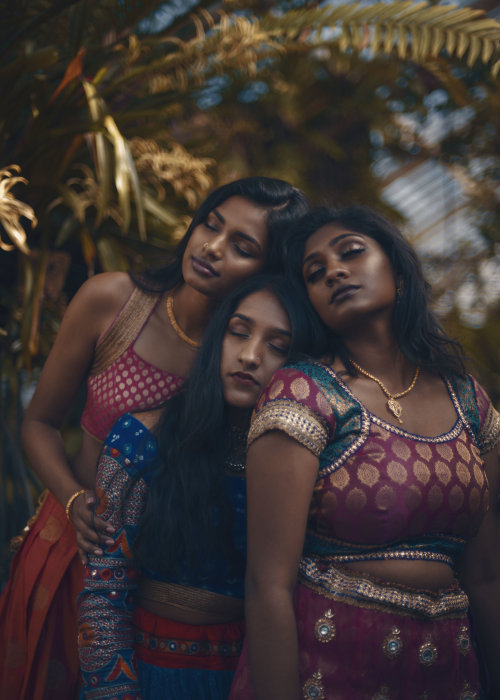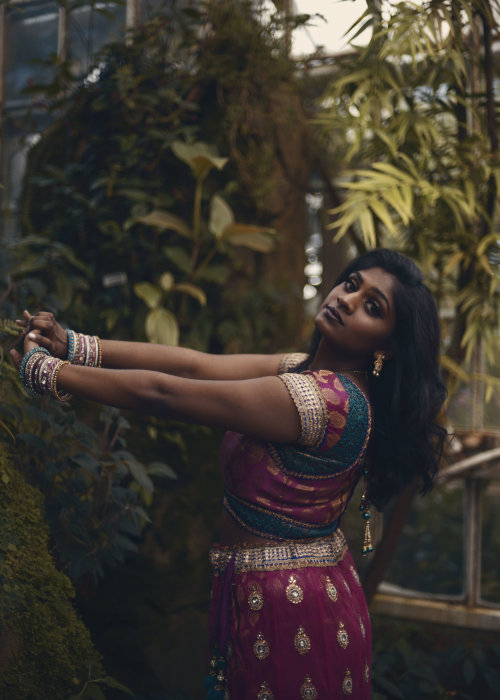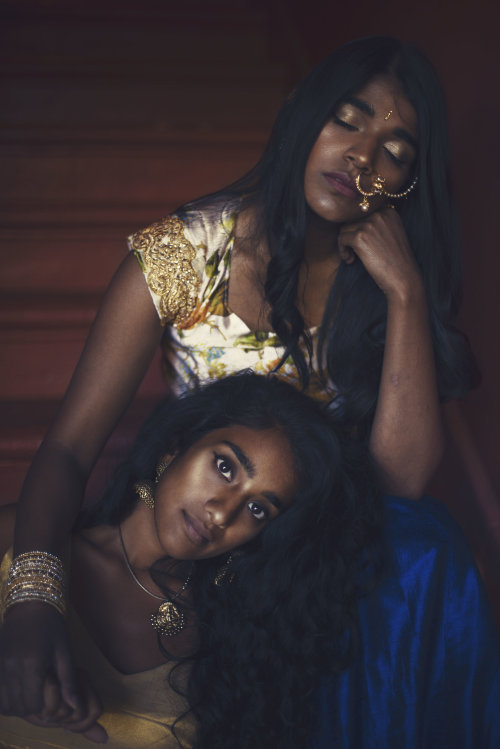Pom

pom
More Posts from Neptuneblueeee and Others
The world is oftentimes such an ugly place, but sometimes it can be so beautiful.
Like, when two choirs, one from Croatia and the other from Zimbabwe, met on the opposite sides of a Lisbon subway station and both sang to each other.
I unfortunately do not know what the Zimbabwe children choir sang to them (although it was so beautiful), but the Croatian klapa Kastav sang 'Kuća puna naroda' (a house full of people).
And let my reward be a house full of people, my life, give me a voice, so I can embrace you with songs.
Video source: Irena Grdinić


wind chime








This photoshoot is dedicated to all the South Asian women out there who are often underrepresented in media simply because the color of their skin doesn’t fit South Asia’s unreasonable, fair&lovely, eurocentric beauty standards. As we all know, colorism is huge in India and Pakistan. Our society has come to the point where people talk about fighting oppression and uplifting women, but no one actually does anything about it. In this photoshoot I wanted to help represent darker skinned girls in the media, and address an issue through fashion photography.
Little girls grow up with their mothers bantering them about their skin color and how a man would never want them because they’re too dark. This does not help a girl’s self confidence, and it’s important to teach them from a young age that they’re beautiful and worthy in order to prevent them from being a self conscious teen. It’s also important to teach other girls that are lighter skinned to support these girls. In high school, a South Asian boy my friend had a crush on said that she was “too dark” and basically implied that’s the reason why he wouldn’t want a relationship with her. Comments like these are what destroy girl’s self confidence, especially when they’re young, vulnerable and lost. Support and help your sisters!
With the rise of young South Asians taking their pride in jewelry and colorful clothes to Instagram, it’s important not to romanticize the culture. Every culture has it’s good and bad, and although it’s totally fine to appreciate and be grateful for the good, we shouldn’t be silent about the bad especially if we are privileged. While our own South Asians are constantly romanticizing our culture, but not acknowledging it’s dirty laundry they are also promoting social marginalization. Women are treated horribly, LGBTQ isn’t a thing (especially in Pakistan), and more of our afro-south asian brothers and sisters are murdered on the streets the longer we stay silent. Instead of bringing light to these issues, our culture keeps quiet.
- Photographer Simrah Farrukh

Blueberry sharks 🫐🦈

ねる…今夜はしずか…
I'm going to sleep... Tonight is so quiet...

ducks!

Hubble captures rare triple moon transit of Jupiter
These new NASA/ESA Hubble Space Telescope images capture a rare occurrence as three of Jupiter’s largest moons parade across the giant gas planet’s banded face. Hubble took a string of images of the event which show the three satellites — Europa, Callisto and Io — in action. There are four Galilean satellites — named after the 17th century scientist Galileo Galilei who discovered them. They complete orbits around Jupiter ranging from two to seventeen days in duration. The moons can commonly be seen transiting the face of Jupiter and casting shadows onto its layers of cloud. However, seeing three of them transiting the face of Jupiter at the same time is rare, occurring only once or twice a decade. The image on the left shows the Hubble observation at the beginning of the event. On the left is the moon Callisto and on the right, Io. The shadows from Callisto, Io and Europa are strung out from left to right. Europa itself cannot be seen in the image. The image on the right shows the end of the event, just over 40 minutes later. Europa has entered the frame at lower left with slower-moving Callisto above and to the right of it. Meanwhile Io — which orbits significantly closer to Jupiter and so moves much more quickly — is approaching the eastern limb of the planet. Whilst Callisto’s shadow seems hardly to have moved, Io’s has set over the planet’s eastern edge and Europa’s has risen further in the west. The event is also shown from start to finish in a video. Missing from this sequence is the Galilean moon Ganymede which was outside Hubble’s field of view. The moons of Jupiter have very distinctive colours. The smooth icy surface of Europa is yellow-white, the volcanic sulphur surface of Io is orange and the surface of Callisto, which is one of the oldest and most cratered surfaces known in the Solar System, is a brownish colour.
Image credit: NASA, ESA, Hubble Heritage Team
Looks like a drunk acrylic pouring kinda night
-
 iwouldliketoeatrandy reblogged this · 1 month ago
iwouldliketoeatrandy reblogged this · 1 month ago -
 anonymousdork liked this · 2 months ago
anonymousdork liked this · 2 months ago -
 exquenine liked this · 3 months ago
exquenine liked this · 3 months ago -
 iwantallthecookies liked this · 3 months ago
iwantallthecookies liked this · 3 months ago -
 danny-ge-1 liked this · 3 months ago
danny-ge-1 liked this · 3 months ago -
 artfulgalaxyinjar reblogged this · 3 months ago
artfulgalaxyinjar reblogged this · 3 months ago -
 faustusdawn liked this · 5 months ago
faustusdawn liked this · 5 months ago -
 telomirage reblogged this · 5 months ago
telomirage reblogged this · 5 months ago -
 friskyo7puns liked this · 5 months ago
friskyo7puns liked this · 5 months ago -
 penname-secrecy liked this · 6 months ago
penname-secrecy liked this · 6 months ago -
 joeywheelersbiggestfan reblogged this · 6 months ago
joeywheelersbiggestfan reblogged this · 6 months ago -
 joeywheelersbiggestfan liked this · 6 months ago
joeywheelersbiggestfan liked this · 6 months ago -
 sillysparks liked this · 7 months ago
sillysparks liked this · 7 months ago -
 shining-needle liked this · 7 months ago
shining-needle liked this · 7 months ago -
 cutiemccuteness reblogged this · 7 months ago
cutiemccuteness reblogged this · 7 months ago -
 panaceleo reblogged this · 7 months ago
panaceleo reblogged this · 7 months ago -
 elegant-hedgehog reblogged this · 7 months ago
elegant-hedgehog reblogged this · 7 months ago -
 fairymage3 liked this · 8 months ago
fairymage3 liked this · 8 months ago -
 catherinebronte reblogged this · 8 months ago
catherinebronte reblogged this · 8 months ago -
 catherinebronte liked this · 8 months ago
catherinebronte liked this · 8 months ago -
 daydream--imaginings reblogged this · 8 months ago
daydream--imaginings reblogged this · 8 months ago -
 admbtflywaterlily reblogged this · 9 months ago
admbtflywaterlily reblogged this · 9 months ago -
 tielt reblogged this · 9 months ago
tielt reblogged this · 9 months ago -
 tielt reblogged this · 9 months ago
tielt reblogged this · 9 months ago -
 thealienufo liked this · 9 months ago
thealienufo liked this · 9 months ago -
 h0neyandtea reblogged this · 10 months ago
h0neyandtea reblogged this · 10 months ago -
 sometimes-a-writer reblogged this · 10 months ago
sometimes-a-writer reblogged this · 10 months ago -
 toastyburntbread liked this · 10 months ago
toastyburntbread liked this · 10 months ago -
 anaryn reblogged this · 10 months ago
anaryn reblogged this · 10 months ago -
 zixio liked this · 10 months ago
zixio liked this · 10 months ago -
 tankequn liked this · 10 months ago
tankequn liked this · 10 months ago -
 complementaryxcolors liked this · 10 months ago
complementaryxcolors liked this · 10 months ago -
 thank-you-thank-you reblogged this · 11 months ago
thank-you-thank-you reblogged this · 11 months ago -
 thankii liked this · 11 months ago
thankii liked this · 11 months ago -
 foxgirlchorix reblogged this · 11 months ago
foxgirlchorix reblogged this · 11 months ago -
 something-writing liked this · 11 months ago
something-writing liked this · 11 months ago -
 lachance69 liked this · 11 months ago
lachance69 liked this · 11 months ago -
 squeakerspeaker reblogged this · 11 months ago
squeakerspeaker reblogged this · 11 months ago -
 squeakerspeaker liked this · 11 months ago
squeakerspeaker liked this · 11 months ago -
 briarroses reblogged this · 11 months ago
briarroses reblogged this · 11 months ago -
 author-omniscient liked this · 11 months ago
author-omniscient liked this · 11 months ago -
 cosmicgamerboy reblogged this · 1 year ago
cosmicgamerboy reblogged this · 1 year ago -
 disgusteeed liked this · 1 year ago
disgusteeed liked this · 1 year ago -
 cosmicgamerboy liked this · 1 year ago
cosmicgamerboy liked this · 1 year ago -
 iilelio reblogged this · 1 year ago
iilelio reblogged this · 1 year ago
